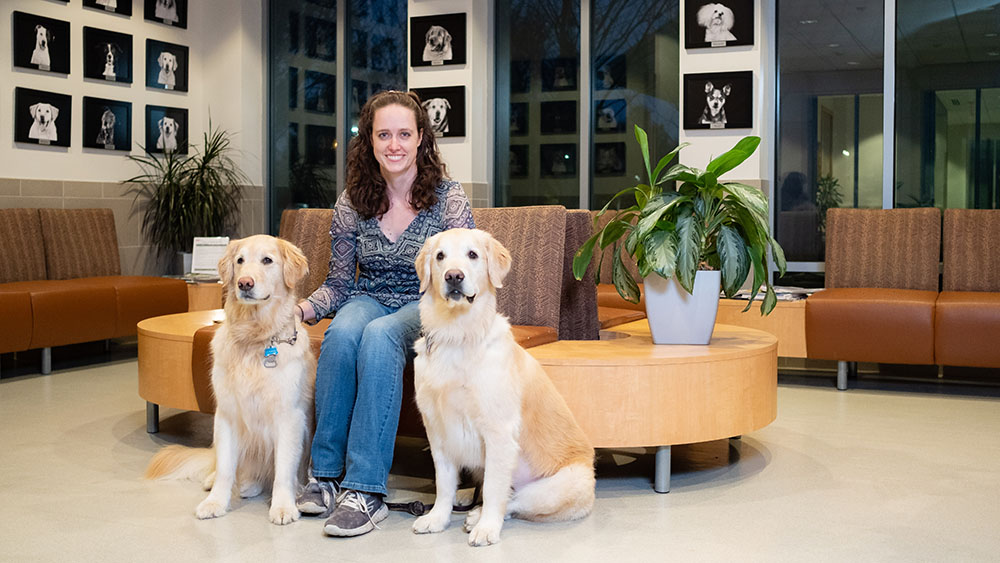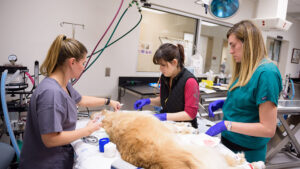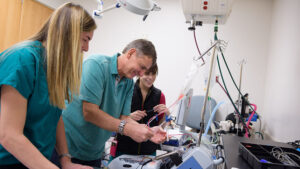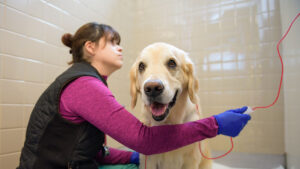Patient Spotlight: A Life-Changing Procedure for a Life-Saving Dog

Good things can still happen on Facebook. It saved Maddie Barnes’ life.
Maddie, a 6-year-old golden retriever, was diagnosed with B-cell lymphoma in September by a veterinary oncologist in Colorado, where Maddie has lived with her owner, Ashley Barnes, since she was 8 weeks old. Before her diagnosis, Maddie had been a blood donor herself. To help other dogs, she was enrolled in the Morris Animal Foundation’s Golden Retriever Lifetime Study, which collects information used by veterinarians and researchers to advance both animal and human health.
Following her diagnosis, Maddie underwent chemotherapy and quickly went into clinical remission. While chemotherapy does not cure lymphoma, it does diminish the burden in the body from the disease to the microscopic level.
In an effort to cure her, Barnes’ vet recommended a bone marrow transplant for Maddie.
Barnes, an associate veterinarian at a Colorado animal hospital, immediately began looking for a suitably matched bone marrow donor. She started with friends, family and co-workers, but couldn’t find a close match.
Eventually, she posted on Facebook that she was still looking for a donor. Very soon, a complete stranger replied that she had a golden retriever, McKinley, from the same breeder, born in a litter with the same parents a month after Maddie was born. After a few meetings and a blood test, it looked like McKinley was a perfect match for Maddie.
“I knew it was a long shot since her half-sibling wasn’t a match,” Barnes said. “But we were very fortunate to find McKinley.”
Two months after their chance encounter, Maddie and McKinley, plus Barnes and a co-worker, boarded a plane to North Carolina. They were headed to the extracorporeal service for a bone marrow transplant at the NC State Veterinary Hospital , the first and only veterinary teaching hospital in the world to offer the service.
A golden opportunity

Marrow, a spongy tissue found within bones, creates immature blood cells known as stem cells. Healthy stem cells are crucial to producing healthy red and white blood cells and platelets, the body’s literal lifeline. Without healthy blood cells, the body can’t transport oxygen or efficiently fight infection and disease.
A bone marrow transplant replaces unhealthy or destroyed bone marrow stem cells with healthy ones. The most common type of transplant, called autologous, involves the collection of stem cells directly from the patient. The rare allogeneic type, like the one Maddie received, involves collecting stem cells from a donor whose immune system is compatible with the recipient’s.
Allogeneic transplants like Maddie’s are uncommon because there are no canine bone marrow registries and it can be difficult for dog owners to locate compatible pet relatives.
“Finding a compatible donor is really significant,” said Alexandra Gareau, a bone marrow transplant fellow. “Finding a healthy donor increases the recipient’s chance at a cure for lymphoma, The mean age for dogs that receive bone marrow transplants is 4 1/2 years old, which is what motivates owners to pursue them. They want more time with their dogs since they are so young.”
Of the 87 bone marrow transplant cases performed at the veterinary hospital since 2008, Maddie’s is only the fifth allogeneic transplant. Currently, the expected cure rate for autologous transplants, defined as patients living disease-free for more than two years after the transplant, is about 33 percent for patients with B-cell lymphoma and 19 percent for cases with T-cell lymphoma.

Cure rates of allogeneic bone marrow transplants are suspected to be higher, but more cases are needed to prove this since five is not a very large data set.
In comparison, a 20 to 30 percent cure rate is significantly higher than the 0 percent cure rate of chemotherapy-only treatments.
The canine bone marrow transplant process, similar to the human process, takes about a month from admission to discharge. There are seven stages:
- Decision Day: Clients thinking about bone marrow transplants contact the bone marrow unit, part of the veterinary hospital’s extracorporeal service, for an initial phone or in-person consultation visit and patient evaluation.
- Pre-admission Conditioning: Before patients are admitted to the hospital for a bone marrow transplant, they receive a high dose of cyclophosphamide, used as chemotherapy, for two weeks before arrival. Conditioning destroys as many of the remaining cancer cells in the patient’s body as possible.
- Admission to the Extracorporeal Service: Five days before apheresis, the patient is admitted to the hospital and undergoes a pre-transplant medical evaluation to make sure the patient is ready for the transplant. If the patient is deemed a good candidate for a transplant, Neupogen is administered for five days. Neupogen drives the stem cells from the bone marrow into the peripheral blood where they can be harvested with an apheresis machine.
- Apheresis (allogeneic or autologous)“: The bone marrow stem cells are harvested using an apheresis machine, which painlessly takes blood out of the patient, removes the needed stem cells and puts all the other blood cells back into the patient while under anesthesia. Since the 1950s, dogs have been utilized to improve bone marrow transplant therapy protocols for human patients. Human apheresis machines, such as the one used at the hospital, can be used without modification for canine transplants, even if the protocols differ.
- Total Body Irradiation: The patient is subjected to irradiation, called total body irradiation or TBI, in an attempt to kill any remaining cancer cells. The amount of irradiation given varies between autologous transplant recipients and allogeneic transplant recipients, ranging between 8 to 12 Gy in unit measurements of radiation.
- Transplant Day (Day 0): The patient undergoes the last TBI treatment and the harvested bone marrow stem cells are delivered into the bloodstream through an intravenous catheter, the same way that a blood transfusion is administered.
- Post-transplant: The injected stem cells migrate to the bone marrow and begin to produce healthy red and white blood cells and platelets. During this critical stage, patients stay in the hospital for two to three weeks, where they are closely monitored to ensure that the bone marrow is recovering and blood cell counts return to normal. Patients also receive gastrointestinal medications for supportive care and antibiotics to fight infections until their bone marrow recovers. When the white blood cell count becomes very low, they spend a few days in a reverse isolation ward for protection against infectious diseases.
- Hospital Discharge: Clients return to the hospital to learn about post-transplant monitoring and care for their dogs at home. Patients return home and begin their road to recovery.
As good as gold

After receiving her bone marrow transplant, Maddie will begin 2019 with a new leash on life. Before long, she will be back to her old self, chasing balls and trying to eat everything in Barnes’ garden.
“Maddie is a ball fiend,” Barnes said. “She is always trying to pick up at least two in her mouth at one time. During the summer, she likes to swim around in the pool, when they open them up to dogs, and try to pick up as many as she can.
“I hope she is back to doing that real soon.”
To learn more about the extracorporeal service and bone marrow transplant, check out their web page.
~Brittany Sweeney/NC State Veterinary Medicine
- Categories:


